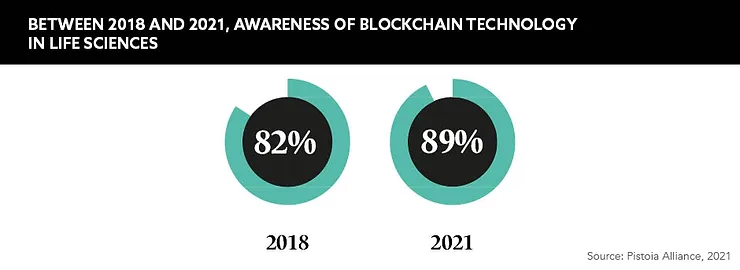Pharma’s digital transformation has been extensive but it could arguably go further. GOLD explores what the pharmaceutical industry’s future might look like with the adoption of blockchain technology within its key functions
Words by Cheyenne Eugene
Digital transformation has become a buzzword in the pharmaceutical sector, tightly woven into the agendas of industry conferences over the past two years. But relatively little airtime has been granted to one of the most promising digital technologies of the 21st century: blockchain. Best known for its role in cryptocurrency, blockchain could hold the key to truly modernising the pharma sector. Some pharma companies are adopting blockchain systems already, but where should the rest of the industry be looking to implement this disruptive technology?
The blockchain basics
Before appreciating how blockchain can transform this multifaceted industry, it is important to understand the nature of the technology. The key difference between a standard database and a blockchain database is how the data is structured and stored. In a standard system, information is held centrally and is managed and protected by a single trusted party, whereas a blockchain database stores sets of information in interconnected groups known as blocks, which have certain storage capacities. When filled, these blocks are closed and linked to the previously filled block using a hash function – a complex form of cryptography. It is this hash function that ensures the immutability of the blockchain.
“Once added, data cannot be deleted or changed,” explains Vincent Steine, Independent Pharma Broker and self-confessed blockchain enthusiast. “This is because changing information will change the contents of the block and therefore the hash, which will require the alteration of every single earlier block in the chain.” The result is that rather than sensitive information being held in one location that can be corrupted or hacked, data is stored in a chain that is impenetrable to these kinds of attacks.
Supply chain solutions
Over the past two years, supply chains have been tested and pharma’s biggest players are already pursuing more effective systems via the use of blockchain technology. As companies depend on third party manufacturing sites in the upstream and external warehouses in the downstream, “making important demand and stock supply decisions within a short time was a challenge”, says Balakrishna Chandrasekaran, former Associate Manager for blockchain at one of the top five pharma companies. “This could be mitigated with the use of blockchain and the digital twin tracking mechanisms,” he adds.
A digital twin is a virtual representation of an object or system that uses real-time data, simulation and machine learning and reasoning to draw intelligent conclusions from data by identifying faults and recommending precautionary measures ahead of critical events. “Digital twins will be the most sought-after solution to identify supply chain pain points,” predicts Chandrasekaran. This technology could be leveraged to make key business decisions involving supply chain risks.
Pharmaceutical supply chains contain a breadth of stakeholders and intermediaries and, in turn, are a prime target for counterfeiters as it is difficult to track, monitor and ensure the authenticity of products. Here, blockchain’s potential is potent. By adding a digital identity to a physical product, robust levels of security can be guaranteed.
Blockchain could hold the key to truly modernising the pharma sector
“This can be done through applying identifiers, such as a barcode, to the product,” says Steine, but he warns that, “these need to be tamper-proof so bad actors cannot insert a counterfeit [product] into the tagged packaging”. Steine suggests that risk can be mitigated by scanning the barcode at each touchpoint and making all of the information available to the manufacturer and regulator using blockchain technology. “The data can also be made accessible to parties with limited infrastructure, such as pharmacies or hospitals, as they could simply use a barcode scanner to verify the authenticity of a product,” he says.
Using the pandemic as an example, Steine explains how blockchain technology could be used to monitor and roll out COVID-19 vaccines of the future. “The system would work by using smart sensors on the transport containers which would collect, store and transmit information on the blockchain,” he explains. “Other authorised parties could then view this information on the blockchain, allowing hospitals, distributors and regulators to check that the vaccines were transported and stored correctly and are therefore safe to use and effective.”
Research and development
Similar to supply chains, the R&D ecosystem consists of dense and complex stakeholder networks. Blockchain technology is already simplifying the clinical trial process in relation to communication and data sharing. “Sensitive data, such as patient health records and clinical trial outcomes, must remain secure,” states Steine. “The trial protocol must be immutable and transparent for all stakeholders, with protocols strictly adhered to.” Communication between stakeholders has historically been a challenge, often labelled as inefficient and easily compromised. “Blockchain is helping to manage patient consent, protect protocols, track patient samples and ensure secure communications between trial sites and therefore stakeholders,” he explains.
Blockchain standards will continue to evolve
Blockchain enables data to be safely shared across an extensive network, greatly benefitting all activities across R&D, and Steine suggests that the possibilities are endless. “Combined with, for example, artificial intelligence, machine learning and other advanced digital tools, blockchain could also accelerate data mining,” he says.
Limitations of blockchain
Despite the possibilities that blockchain offers the pharma world, leaders are still hesitant to implement it into their processes. Chandrasekaran believes there are a multitude of reasons for this. Elaborating on one in particular, he says: “Blockchain standards will continue to evolve, and new tech will keep developing. Hence, blockchain interoperability is a key challenge that enterprises are foreseeing as a hurdle.” He assures that solutions are being actively pursued and that “hierarchical blockchain” is incoming.
Steine also highlights limitations of blockchain, including “significant upfront costs”, in terms of financial investment and resources, which can stunt uptake of the technology. “Justifying this initial financial investment may present challenges since most of the largest pharmaceutical companies… are managed and evaluated on a short-term basis by their investors,” he explains. Steine also raises concerns over the ‘wait-and-see mentality’ that is common around the implementation of new systems and associated disruption of existing processes. “Blockchain will have massive implications on how information is managed across the pharma supply chain,” he says. “Considering the sensitivity of this information, as well as the potential fallout from order information being lost or compromised, some companies will want to observe how the implementation of this new technology will play out.”
However, blockchain cannot revolutionise the industry without mass participation and Chandrasekaran highlights the importance of making blockchain accessible. “Providing smaller firms with affordable and well-rounded options to be a part of blockchain will be key to driving deeper adoption,” he says. In addition, he suggests that options involving patients and governments should be explored and the key benefits demonstrated, thus creating a ‘pull effect’ that leads to wider blockchain implementation.
Looking to the future
Currently, the priority of blockchain implementation within the pharma industry is centred around supply chain management, anti-counterfeiting strategies and optimising clinical trial processes. However, both Steine and Chandrasekaran predict the technology will penetrate other facets of pharma, with suggestions that venture capital, intellectual property and vendor contract management could be next in line for transformation. “The success of this purely depends on the participation of all parties involved, including the companies and government,” explains Chandrasekaran. “After all, blockchain is a team sport.”
Blockchain solutions could make a substantial difference to the industry, but can pharma be bold enough to turn digital transformation into a digital revolution?







